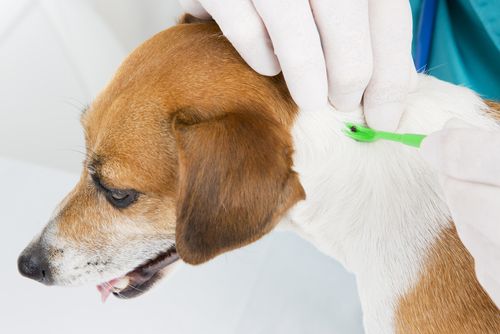
What is Heartworm?
Heartworm is a serious illness that can cause heart failure, lung disease, organ damage and even death in dogs, cats and ferrets. Heartworm is most prevalent in pets living along the Atlantic Gulf coasts from New Jersey to the Gulf of Mexico, and in those living alongside the Mississippi and its main tributaries. However it has been found in pets in all of the US States.
What causes Heartworm?
Heartworm is caused by parasitic worm larvae that lives inside mosquitoes. When the mosquito bites an animal it transfers some worm larvae into it where the larvae then matures, mates and produces offspring inside its living host. The offspring produced by female adult heartworms is known as microfilariae and lives in the host animals’ blood stream. When a mosquito then bites an infected animal it draws microfilariae into its body where it turns it into infective larvae, beginning the cycle again.
Once an animal has been infected it takes time for the larvae to mature into adults that are capable of reproduction. In dogs this period is usually 6-7 months and in cats and ferrets around 8 months. Adult heartworms look like cooked spaghetti and can range in size from 4-6 inches in males and 10-12 inches in females. The number of worms found in a pet is known as its ‘worm burden’ and this can vary depending on the species of animal and the severity of the infection.
Heartworm in Dogs
The lifespan of heartworms within an infected dog is between 5 and 7 years and the average worm burden is 15. However dogs have been seen with worm burdens ranging from 1 to 250.
Symptoms of Heartworm in Dogs
The severity of the symptoms of heartworm in dogs is dependent on the worm burden of the animal, how long they have been infected and how well their body can cope with the disease. However, it is usually broken down into four stages.
Class 1: no visible symptoms or very mild symptoms such as an intermittent cough or wheeze.
Class 2: mild to more moderate symptoms including intermittent coughing and lethargy or breathlessness after light to moderate exercise. At this time some heart and lung changes may be seen on x-rays.
Class 3: symptoms will include frequent or persistent coughing, lethargy, and breathlessness after mild activity. Heart and lung changes will definitely be visible on x-rays.
Class 4: this stage is otherwise known as Caval Syndrome and is reached when an infected animal has been left untreated for an extended period of time. At this stage, the animal experiences restricted blood flow to the heart caused by a blockage of worms. Heart failure is imminent and emergency surgery to remove the worms is the only course of action. However, this comes with its own risks and most dogs with Caval Syndrome do not survive.

It turns out that owning a pet is more than just adorable cuddles and trips to the dog park. Owning a pet can also improve your overall health and wellness.
On a psychological level, pets are shown to decrease levels of depression and anxiety. On an overall health level, owning a pet can decrease your blood pressure, increase your immune system, making you less likely to suffer from a heart attack and stroke, and more.
1. Get a Pet & Get Rid of Stress
A study in 2002 by the State University of New York at Buffalo found that having your pet around during difficult tasks can decrease stress. They found that having pets helped participants stay calm and focus on the task at hand. Pets were even more beneficial than having a close friend or family member nearby.
Promises Treatment Centers, which help to recover drug addicts allows pets into their rehab facilities. The CEO of the facility recommends that having your pet around makes the recovery process less stressful, making drug addicts less likely to reach for substances as a way to decompress.
So, the next time you’re going through a tough time at home or work, try taking a breather to hang out with your pets.
2. Own a Pet & Lower Your Blood Pressure
A study by the CDC suggests that having a dog can lower your blood pressure, especially for high-risk hypertensive patients. Oftentimes, stress can cause high blood pressure. When life throws you stressful curveballs, having a dog (or cat) that loves you unconditionally can help you feel at ease. It’s also thought that owning a pet gives you more opportunities to go outside and exercise, which strengthens your heart and lowers your blood pressure.
3. Raise a Pet and Lower Your Cholesterol
The CDC suggests that another healthy component of owning a pet is lowering your cholesterol. Research found that people who own pets (particularly men) have lower levels of cholesterol and triglycerides than those without pets. Who needs Cheerios, when you can get a dog. Like lower blood pressure, it’s not known if the pet’s presence is specifically lowering cholesterol, or if it’s caused by the lifestyle that comes with owning a pet.

What are Ticks?
Ticks are arachnids that belong to the same family as spiders and mites. They are parasitic and feed on the blood of host animals. They are visible to the naked eye, but the start of around the size of a pinhead before swelling with blood as they feast.
Animals living in the Southern States or near heavily wooded areas will have increased exposure to ticks which like to live in thick long grass, as it allows them to attach to host animals as they walk by. They are most active during the late spring and summer months and they are not fussy which breeds of animals they feed on. However, animals that spend a lot of time outdoors will be more susceptible to ticks.
Symptoms of Ticks
Animals with few ticks can present with little or no symptoms and it is often not until there is a larger infestation or infection from the bites that signs become apparent. If and when symptoms do materialize they can include itching, scratching and visible red or inflamed irritations on the skin.
Ticks can transmit a number of diseases including Babesia, Cytauxzoonosis, Lyme disease, and Mycoplasma. Some animals can also have allergic reactions to tick bites which result in infections. Symptoms from these reactions or diseases can include fever, lethargy, loss of appetite and pain and can last for several days or several weeks. If you are concerned that your pet has developed illness from a tick bite, consult with your veterinarian as soon as possible.

Lameness is one of the most prevalent problems presented to equine veterinarians. The term is used to describe an abnormal gait or stance due to the animal feeling pain or experiencing a restriction in the normal range of movement caused by underlying mechanical or neurological problems. The pain or restriction can originate from any part of the body such as the hoof, the leg or neck. The degree of severity can vary from a mild change in gait to completely preventing the horse from using or bearing weight on the affected limb. Unfortunately, lameness is the primary reason that older horses are put down.
Why might my horse be lame?
There are many reasons why a horse can become lame, but some of the most common reasons include:
Abscesses or bruises in the hoof
Back and neck problems
Degenerative joint diseases
Fractures
Laminitis – inflammation of the soft tissue structures which attach the pedal bone to the hoof wall
Ligament injuries
Tendon damage

Keeping your pet safe is the most important part of keeping both you and your pet happy. When you first adopt a pet or new breed of pet — or even better, before you adopt them — be sure to research the basics of your pet. When you finally select a pet, talk to the shelter staff about things you might need to worry about or watch out for. Of course, you can always stop by with your pet to discuss behaviors, concerns, or anything else.
Below we've got some general notes on basic safety tips, whether indoors or outdoors. Remember that traveling —that's more than a quick jog to the park or a ride across town for a play date— may require some extra steps based on the species of your pet. Traveling at any distance can give some pets anxiety, and there are other physical safety factors to consider. Come by and talk to us about what you may need, especially if you're about to travel abroad!

Not everyone is lucky enough to live in a State with relatively consistent weather and temperatures. Just as humans change their behavior and diet with fluctuations in temperature, so do most animals. Here are our guidelines for seasonal care for your pets.
Winter
If temperatures plummet and your pet usually likes to spend most of its time outdoors try and persuade them to stay indoors in the warm instead. If circumstances mean that your pet has to be kept outdoors then take steps to ensure that they are as warm and comfortable as possible. This means providing them with a dry and draft-free shelter with plenty of extra blankets. You should also regularly check their water supply to ensure that it hasn’t frozen.
If the ground is covered with snow, ice or just extremely cold then you may want to consider animal booties. These are widely available from most pet stores.
Be prepared to see a change in your pet's eating habits. Outdoor pets tend to require extra food. They burn this extra food to help keep them warm. Indoor pets are likely to eat far less as they conserve energy by sleeping more.
Keep your pets away from antifreeze. Unfortunately, it smells and tastes delicious to dogs and cats, but even the smallest sip can be deadly. Keep pets out of garages and outbuildings and clean up any spillages as soon as they happen. Speak to your neighbors about the dangers and ask them to ensure that any antifreeze they have is securely stored and that they too clean up any spillages that may occur. If your pet acts as if they are drunk or begins to convulse then take them to a vet immediately.
Check under the hood of your car before starting the engine. Many cats like to sneak under the hood of a vehicle once you have gone inside so that they can curl up against the warm engine. If you are unable to open the hood then a firm tap on it should be sufficient to wake any sleeping cat.
Ensure that rabbit hutches are brought inside. If this isn’t possible then ensure that you put extra newspaper in for insulation. Again, check their water source to ensure that it isn’t frozen.

Our pets are beloved members of our family and it can be heartbreaking to see them unwell. Unfortunately, there are some illnesses that pets are unable to recover from. In the case of terminal illness and/or debilitating pain or suffering, one of the kindest things that we can do for them is to relieve them of that burden by making the difficult decision to put them to sleep.
How do I know if it is the right time to consider euthanasia?
Your veterinarian is the best person to advise you when it is time to consider euthanizing your pet. However there are also some signs and symptoms that your pet is no longer experiencing a good quality of life, and if you notice these then it would be advisable to contact your veterinarian to determine if euthanasia would be the most humane course of action. These signs include:
Chronic labored breathing, breathlessness and/or coughing
Chronic pain that cannot be controlled by medication (your veterinarian can advise if this is the case)
Frequent diarrhea and/or vomiting that leads to dehydration or severe weight loss
Inability to stand or move around
Disinterest in food or eating
Incontinent to the stage where they are frequently soiling themselves
No interest in communication with family members, treats, games, or other previously enjoyed activity
Zest for life is non-existent
Euthanasia has the small benefit of allowing family members the time to say their final goodbyes to your pet. This is an emotional time and giving them the opportunity for final displays of love and affection with their pets will help ease them into the grieving process. It is especially important to prepare young children as this may be their first experience of bereavement.
Many veterinarians will allow you to be present during the euthanasia procedure so that you can comfort your pet as they enter their final journey. This is a personal decision, but it is recommended that young children are not present during this time.

What is Heartworm?
Heartworm is a serious illness that can cause heart failure, lung disease, organ damage and even death in dogs, cats and ferrets. Heartworm is most prevalent in pets living along the Atlantic Gulf coasts from New Jersey to the Gulf of Mexico, and in those living alongside the Mississippi and its main tributaries. However it has been found in pets in all of the US States.
What causes Heartworm?
Heartworm is caused by parasitic worm larvae that lives inside mosquitoes. When the mosquito bites an animal it transfers some worm larvae into it where the larvae then matures, mates and produces offspring inside its living host. The offspring produced by female adult heartworms is known as microfilariae and lives in the host animals’ blood stream. When a mosquito then bites an infected animal it draws microfilariae into its body where it turns it into infective larvae, beginning the cycle again.
Once an animal has been infected it takes time for the larvae to mature into adults that are capable of reproduction. In dogs this period is usually 6-7 months and in cats and ferrets around 8 months. Adult heartworms look like cooked spaghetti and can range in size from 4-6 inches in males and 10-12 inches in females. The number of worms found in a pet is known as its ‘worm burden’ and this can vary depending on the species of animal and the severity of the infection.
Heartworm in Dogs
The lifespan of heartworms within an infected dog is between 5 and 7 years and the average worm burden is 15. However dogs have been seen with worm burdens ranging from 1 to 250.
Symptoms of Heartworm in Dogs
The severity of the symptoms of heartworm in dogs is dependent on the worm burden of the animal, how long they have been infected and how well their body can cope with the disease. However, it is usually broken down into four stages.
Class 1: no visible symptoms or very mild symptoms such as an intermittent cough or wheeze.
Class 2: mild to more moderate symptoms including intermittent coughing and lethargy or breathlessness after light to moderate exercise. At this time some heart and lung changes may be seen on x-rays.
Class 3: symptoms will include frequent or persistent coughing, lethargy, and breathlessness after mild activity. Heart and lung changes will definitely be visible on x-rays.
Class 4: this stage is otherwise known as Caval Syndrome and is reached when an infected animal has been left untreated for an extended period of time. At this stage, the animal experiences restricted blood flow to the heart caused by a blockage of worms. Heart failure is imminent and emergency surgery to remove the worms is the only course of action. However, this comes with its own risks and most dogs with Caval Syndrome do not survive.

Also known as CDV, Canine Distemper is a highly contagious viral illness that can be debilitating and even fatal. It not only affects dogs but can also be seen in certain species of wildlife, including foxes, skunks, and wolves. Puppies and non-immunized dogs are most commonly affected, but pets on immune-suppressants may also be vulnerable.

Keeping your pet safe is the most important part of keeping both you and your pet happy. When you first adopt a pet or new breed of pet — or even better, before you adopt them — be sure to research the basics of your pet. When you finally select a pet, talk to the shelter staff about things you might need to worry about or watch out for. Of course, you can always stop by with your pet to discuss behaviors, concerns, or anything else.
Below we've got some general notes on basic safety tips, whether indoors or outdoors. Remember that traveling —that's more than a quick jog to the park or a ride across town for a play date— may require some extra steps based on the species of your pet. Traveling at any distance can give some pets anxiety, and there are other physical safety factors to consider. Come by and talk to us about what you may need, especially if you're about to travel abroad!






